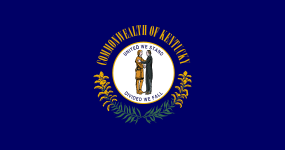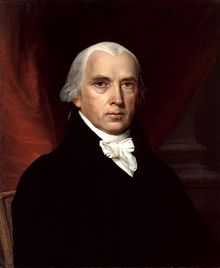Benjamin Franklin Graves
Benjamin Franklin Graves (1771–1813)[1] was a politician and military leader in early 19th-century Kentucky. During the War of 1812, Graves served as a Major in the 2nd Battalion, 5th Kentucky Volunteer regiment.[1][2] Together with other officers, he commanded relatively inexperienced Kentucky troops in the Battle of Frenchtown (also known as the Battle of the River Raisin) in Michigan Territory. This battle had the highest number of American fatalities in the war: of 1000 American troops, nearly 400 were killed in the conflict on January 22 and 547 were taken prisoner.[3] The next day an estimated 30-100 Americans were killed by Native Americans after having surrendered.
Graves was among Americans known to be taken by the Potawatomi on a forced march to Detroit, Michigan. He is believed to have died on the way, as he disappeared from the historic record. Because so many men of the Kentucky elite were lost in this battle, it has been commemorated in the state. Graves is included among the officers memorialized on Kentucky's Military Monument to All Wars in the state capital of Frankfort. In 2009, the Michigan area was commemorated as the River Raisin National Battlefield Park, the only such park to mark a War of 1812 site, although others are noted as national or state historic sites.
Personal life and politics
Graves was born in Virginia's Spotsylvania County in 1771. After the American Revolutionary War, he moved in 1791 to frontier Kentucky with his siblings and widowed mother. among them was his brother Thomas Coleman Graves. They settled in Fayette County, where he was elected to two terms (1801 and again in 1804) as state representative.[1] This was in the central Bluegrass region, one of the first areas to be settled. He married Polly Dudley, daughter of Ambrose Dudley and Ann Parker.[4] Together they had six children.[1][5]
Military career and presumed death
During the War of 1812, Graves served under Colonel William Lewis as Major in the 2nd Battalion, 5th Kentucky Volunteer regiment.[1] He was commanding officer of Nathaniel G. S. Hart.[2] Nearly one thousand Kentucky troops were sent to Michigan Territory in a United States effort to take Detroit, which was under the control of the British. On January 18, they defeated British and Native American forces at Frenchtown south of Detroit, despite relative inexperience on the battlefield.
In fighting at the second Battle of Frenchtown on January 22, when the British and Native Americans ambushed the Americans, Graves was shot in the knee; he bandaged his wound himself and told his men to continue fighting.[6] After the death of Colonel John Allen,[7] field command of the Kentuckians came to rest on Graves and Major George Madison.[8] [note 1] Nearly 400 Americans were killed during the battle, the highest number of Americans in any single battle of the war, and 547 were taken prisoner at surrender.[3][9]
Upon General Winchester's orders, Graves and hundreds of other survivors surrendered to British forces.[6] His younger brother, Lieutenant Thomas Coleman Graves (a 1st Lieutenant of the 17th Infantry), was killed during the battle.[2][10] After the surrender, British officer Captain William Elliott, a Loyalist, asked to borrow Graves' horse, saddle and bridle. Elliott promised that he would send back additional help for the wounded Americans but the help never arrived.[11]
On January 23, Graves and other injured Americans were captured by the Potawatomi during the River Raisin Massacre.[1] Graves, Timothy Mallory, Samuel Ganoe, and John Davenport, were all held as prisoners with Mallory and Ganoe later escaping.[10] The next day Graves was among the prisoners being marched to Detroit, but his name subsequently disappears from written records.[11][12]
Graves was reportedly seen near Detroit on the River Rouge.[13][14] He was not definitively heard from again and is presumed to have died during the march. The Powatatomi were known to have killed prisoners who could not keep up.[15][16] Other Americans died on the forced march to Fort Malden in Ontario.
General Winchester wrote a February 11, 1813, letter about the battle to the US Secretary of War, which was widely published in American newspapers at that time. He mentioned Major Graves and his fellow officers, saying "they defended themselves to the last with great gallantry".[17] After Graves' disappearance while a prisoner, for years "his widow kept a light burning at the window of their home" in case he would return.[18]
Memorials

(Kentucky War Memorial Frankfort, KY)
- Graves County, Kentucky was created and named in his honor in 1823.[1]
- His name is inscribed, along with the names of his fellow officers who fell at the Raisin, on Kentucky's Military Monument to All Wars in the Frankfort Cemetery in the state capital.[19]
- 2009, the area was established as River Raisin National Battlefield Park, the only one to commemorate a battle of the War of 1812. (Three other battlefield parks commemorate battles of the American Civil War.)
Notes
- ↑ Madison was a 2nd-cousin of President Madison and after the war was elected Governor of Kentucky. (See "The Kentucky Encyclopedia", page 601.)
References
- ↑ 1.0 1.1 1.2 1.3 1.4 1.5 1.6 Kleber, John E. (1992). The Kentucky encyclopedia. University Press of Kentucky. p. 384. Retrieved November 7, 2011.
- ↑ 2.0 2.1 2.2 "American Dead at the Battle of the River Raisin (sourced from Clift's "Remember the Raisin")". Government of Monroe County, Michigan. Retrieved November 8, 2011.
- ↑ 3.0 3.1 Eaton, John (2000). Returns of Killed and Wounded in Battles or Engagements with Indians and British and Mexican Troops, 1790–1848, Compiled by Lt. Col J. H. Eaton. Washington, D.C.: National Archives and Records Administration. p. 7.
- ↑ Pratt, Mary B. "Our Relations: Dudley-Pratt Families". Indianapolis: Pratt Poster Co. (Lexington, Kentucky: University of Kentucky, Electronic Information Access & Management Center, 2002). p. 5. Retrieved November 7, 2011.
- ↑ Pratt, Page 15
- ↑ 6.0 6.1 Young, Bennett Henderson (1903). The Battle of the Thames, in Which Kentuckians Defeated the British, French, and Indians, October 5, 1813. J. P. Morton and company (Filson Club). p. 22. Retrieved November 7, 2011.
- ↑ Battle of the Thames, Page 21
- ↑ The Federal Writers Project (1939). Military History of Kentucky. Works Progress Administration. p. 43. Retrieved November 8, 2011.
- ↑ William Dunbar and George May (1995). Michigan: A History of the Wolverine State. Grand Rapids: Eerdmans Publishing Company. pp. 130–131. ISBN 0-8028-7055-4.
- ↑ 10.0 10.1 Bunch, Mildred (July 15, 2003). Clark, Fran, ed. "War of 1812 Soldiers". Jessamine Historical Quarterly 2 (3): 7. Retrieved November 8, 2011.
- ↑ 11.0 11.1 C. Benjamin Richardson, ed. (1871). The Historical magazine, and notes and queries concerning the antiquities, history, and biography of America (The Massacre at Frenchtown, Michigan, January 1813 by Reverend Thomas P. Dudley). p. 30.
- ↑ Richardson/Dudley, Page 29
- ↑ Antal, Sandy (2008). "Remember the Raisin! Anatomy of a Demon Myth". War of 1812 (10). Retrieved November 8, 2011.
- ↑ H. Niles, ed. (1813). "Ensign Baker's Statement" (Niles' Weekly Register, Volume 4 - Saturday April 10, 1813). Baltimore: Franklin Press. p. 94. Retrieved November 8, 2011.
- ↑ Young, Battle of the Thames, Page 26
- ↑ Hay, Melba Porter; Dianne Wells; Thomas H. Appleton (2002). Roadside History: A Guide to Kentucky Highway Markers. University Press of Kentucky. p. 68. Retrieved November 7, 2011.
- ↑ "Copy of a letter from Brigadier General James Winchester (February 11, 1813)". Connecticut Mirror. March 22, 1813. p. 2.
- ↑ Thayer, William Roscoe (November 1915). "Memoir of Lucien Carr". Proceedings of the Massachusetts Historical Society, Volume 49. p. 92. Retrieved December 15, 2011.
- ↑ Johnson, Lewis Franklin (1921). History of the Franklin Cemetery. Roberts Printing Co. p. 16. Retrieved November 8, 2011.
| |||||||||||||||||||||
| ||||||||||||||||||||||||||||||||||||||||||

-2.png)
